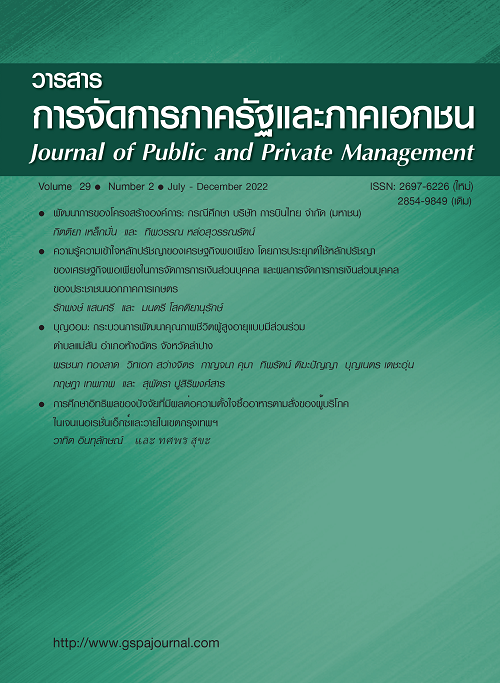Development of Organizational Structure: A Case Study of the Thai Airways International Public Company Limited
Keywords:
Organizational Structure, Thai Airways International Public Company LimitedAbstract
This article aims to study the structural development of the Thai Airways International Public Company Limited by using qualitative methodology. This study collects documentary researches which consist of data from various sources, news, academic articles, and annual report to get more diverse and reliable information.
The finding shows that the structural development of the Thai Airways International Public Company Limited since the company has established in 1959-2016, which is divided into 3 phases. In phase 1, between 1959-1990 during the company was establishing and the beginning has a simple organizational structure; therefore the chain of command is not complicated. In phase 2, between 1991-2006 the company was doing full-time business as a public company limited. By this stage, the company was making continuous growth in business profits and was having expanded structures. The hierarchies of command lines were complex and strictly focus on the rules of operation, resulting in the structure having a bureaucracy that was affecting freedom and flexibility in operations. Finally, in phase 3 between 2007-2016 the company faced continuous losses in profits and brought about an urgent recovery process according to the 2015-2017 reforming plan. The changes in the organization structure of the company are consistent with Larry Greiner’s Life-Cycle Model but at the same time, this model does not develop the external environment changes, especially during the current period that the company faced with intense competition; therefore the company need to adjust the structure to be more strengthen and flexible.
References
Aucoin, P. (1990). Administrative reform in public management: Paradigms, principles, paradoxes and pendulums. Governance, 3(2), 115-137.
Chopra, S., & Lisiak, R. (n.d.). How Should Airlines Structure? A Comparison of Low Cost and Legacy Carriers. Retrieved from http://www.kellogg.northwestern.edu
Hood, C. (1991).A public management for all season? Public Administration, 69(1), 3-19
Fuangjun, S. (B.E.2529). Theory and Concepts of Public Administration. Bangkok.
Inamori, K. (2013). Amoeba Management: The Dynamic Management System for Rapid Market Response. Boca Raton, FL: CRC Press.
Lorsuwannarat, T. (B.E.2557). Modern Organization Theory. 14th ed. Bangkok: Saetfo Printing.
______________. (B.E.2561). Change and Transformation for the Future Organization. Bangkok: Graduate School of Public Administration, National Institute of Public Administration (NIDA).
McCulloch, G. (2004). Documentary Research in Education, History and the Social Sciences. London: RoutledgeFalmer.
Romano, L. (2012). Organizational Structures. Focus on the Airline Sector: The Air-France-KLM Cargo Reorganization. Thesis submitted to the Departmento di Economia e Management,
LUISS Guido Carli. Retrieved from http://tesi.luiss.it/8168/1/romano-tesi-2012.pdf.
Scott, J. P. (ed.). (2006). Documentary Research. Thousand Oaks, CA: Sage Publications.
Sirasoontorn, P. (B.E.2550). Privatization of State Enterprise in the Thaksin Government. The Thailand Research Fund.
SCB Economic Intelligence Center. (B.E.2557). Low Cost Airline Business ... Competition in the Thai Airspace. Retrieved September 5, B.E.2561 from https://www.scbeic.com/th/detail/product/320.
Thai Airways International Public Company Limited. (B.E.2557). Strategic Plan of the Thai Airways International Public Company Limited.
__________________________________________. (B.E.2559). Organizational Structure of the Thai Airways International Public Company Limited. Retrieved March 18, B.E.2561 from thaiairways.com.
__________________________________________. (B.E.2560a). Thai Airways International Public Company Limited Annual Report (B.E.2533-2534). Retrieved February 10, B.E.2561 from http://thai.listedcompany.com/misc/ar/THAI-AR1991.pdf.
__________________________________________. (B.E.2560b). Thai Airways International Public Company Limited Annual Report (B.E.2534-2543). Retrieved February 15, B.E.2561 from http://thai-th.listedcompany.com/ar.html.
__________________________________________. (B.E.2560c). Organizational Structure of the Thai Airways International Public Company Limited (B.E.2534). Retrieved March 18, B.E.2561 from http://thai.listedcompany.com/misc/ar/THAI-AR1991.pdf.
__________________________________________. (B.E.2560d). Organizational Structure of the Thai Airways International Public Company Limited (B.E.2547). Retrieved March 18, B.E.2561 from
http://thai-th.listedcompany.com/ar.html.
The Office of the Securities and Exchange Commission. (B.E.2560). Thai Airways International Public Company Limited Annual Report. Retrieved February 10, B.E.2561 from https://market.sec.
or.th/public/idisc/th/Viewmore/fs-r562?searchSymbol=THAI.
Vipaweekul, T. (B.E.2543). Privatization: A Case Study of Thai Airways International Public Company Limited. An Independent Study. Faculty of Political Science. Thammasat University. Retrieved September 20, B.E.2560 from https://tdc.thailis.or.th/tdc/dccheck.php?Int_code=93&RecId=11032&obj_id=179499&showmenu=no.
Downloads
Published
How to Cite
Issue
Section
License

This work is licensed under a Creative Commons Attribution-NonCommercial-NoDerivatives 4.0 International License.



